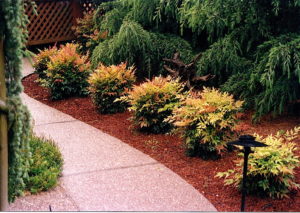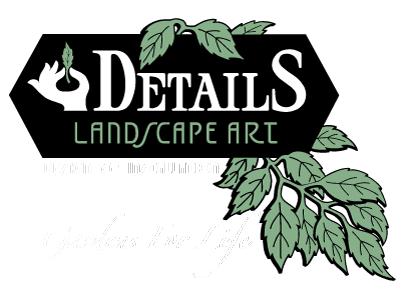Details Landscape Art has been installing patios, walkways, driveways and steps since 1991. Our beautiful hardscape projects can be seen in Petaluma, Santa Rosa, Windsor, Sebastopol, Healdsburg, Rohnert Park, Cotati, Penngrove, Sonoma and Kenwood. We have offered flagstone, brick, stamped concrete, exposed aggregate and tile and various combinations of these. Although flagstone and stamped concrete have been extremely popular the last several years, exposed aggregate remains an excellent lower cost choice. Styles change over time – in the early ninety’s when we first started in business, exposed aggregate was all the rage. So we learned our craft well, and became experts, especially at seeded exposed aggregate, and we still do install this type of hardscape from time to time. It is especially beautiful with complementary accents, such as the charcoal brick trim on the steps in the photo below.

There are basically two types:
Natural Exposed Aggregate – Concrete consists of cement and aggregate (rock). In the North Bay, gray river rock is used as the aggregate – it may be 3/8 river rock, half inch river rock, or three quarter inch river rock. When water is added to the dry concrete mix and poured, the fluid concrete, which is the texture of pancake batter, assumes the shape of the forms set up beforehand. We float the concrete flat, cut score marks (expansion joints), and smooth the edges. Then we hard trowel the surface which brings the ‘cream’ to the top. After a period of time (depending on temperature and moisture in the air), the concrete begins hardening. At a critical point in this hardening (curing) process, we gently hose off the ‘cream’ on the surface, thereby ‘exposing’ the natural aggregate rock. We are careful not to hose too aggressively, else more of the rock is exposed and the resulting surface is rough to the touch and uncomfortable to walk on barefoot. So we do what’s called a ‘light wash’.
Seeded Exposed Aggregate – Same process as above, with one additional step. After the concrete is floated is poured and floated to an even flat surface, an external rock is broadcast or ‘seeded’ over the surface. Usually a 3/8 or ½ inch size colored rock is gently tossed on the still wet concrete so that the entire area is covered. This rock is then pressed down with a float so that it disappears just below the surface. Next is the hard troweling to bring the cream to the surface, and when the concrete sets up to the appropriate consistency, the cream is gently hosed off, ‘exposing’ the seed rock (aggregate). There is a variety of seed rock available, such as Pami Pebbles, Salmon Bay, Trinity, Salt & Pepper, and Mexican Pebbles.
Seeded exposed aggregate is a little more expensive than natural exposed aggregate, due to the cost of the seed rock and the extra labor required to ‘seed’ the concrete. Both types can be sealed or not, depending on the homeowner’s preference. We have done beautiful hardscape projects throughout Sonoma County, using seeded exposed aggregate in combination with either brick or flagstone borders.

